 W
WAkiyoshidai Kokutei Kōen (秋吉台国定公園) is a Quasi-National Park in Yamaguchi Prefecture, Japan. It was founded on 1 November 1955 and has an area of 45.02 km².
 W
WAtera Seven Falls is a waterfall in the city of Shinshiro, Aichi Prefecture, Japan. It has been protected as both a Place of Scenic Beauty and Natural Monument since 1934. The waterfalls was named one of "Japan’s Top 100 Waterfalls", in a listing published by the Japanese Ministry of the Environment in 1990.
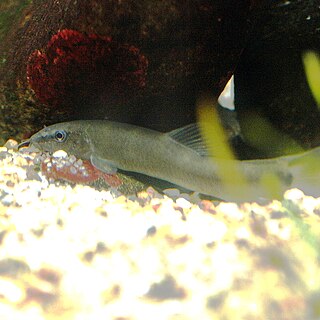 W
WThe Ayumodoki or Kissing Loach is a species of ray-finned fish in the family Botiidae. It is found in lakes and streams on Honshu, the largest island of Japan. Spawning grounds for kissing loach are ditches and small reservoirs for rice cultivation of a river system located in Japan. The kissing loach migrates to flooded areas, including paddy field areas, for spawning in early summer and the spawning of this species is limited after the formation of flooded areas over terrestrial vegetation. These flooded areas are the result of water from mountain streams and irrigation ponds flooding once dry land which create creating man-made wetlands. As, adults, Parabotia curtus migrate from these flooded paddy fields to fast moving, muddy streams and rivers like the Yodo River.
 W
WThe brant or brent goose is a small goose of the genus Branta. There are three subspecies, all of which winter along temperate-zone sea-coasts and breed on the high-Arctic tundra.
 W
WThe Cedar Avenue of Nikkō is the popular name for three separate tree-lined sections of roads in the city of Nikkō, Tochigi in the northern Kantō region of Japan. These roads are the Nikkō Kaidō, Nikkō Reiheishi Kaidō and Aizu Nishi Kaidō and the 13,000 cryptomeria trees lining a total of 35.41 kilometers (22.00 mi) of these roads form a monumental approach to the Shrines and Temples of Nikkō. Although it is not a single continuous road, the "Cedar Avenue of Nikkō" is listed in the Guinness Book of World Records as the longest tree-lined avenue in the world. and is the only cultural property designated by the Japanese Government as both a Special Historic Site and a Special Natural Monument.
 W
WChiiwa Gorge is a river gorge and scenic spot located within the city of Shinshiro, Aichi Prefecture, Japan. It has been protected as both a Place of Scenic Beauty and Natural Monument since 1934.
 W
WDaisetsuzan National Park , or Taisetsuzan is located in the mountainous center of the northern Japanese island of Hokkaidō. At 2,267.64 square kilometres (875.54 sq mi), Daisetsuzan is the largest national park in Japan, and is approximately the size of Kanagawa Prefecture. Daisetsuzan, meaning "great snowy mountains", an apt description of these peaks. There are 16 peaks over 2,000 metres (6,600 ft) in Daisetsuzan National Park, both with and without trails. The park offers some of the most rugged scenery in Japan. Asahidake, located in the north of the park, is the highest peak in Hokkaidō. Daisetsuzan National Park spans two subprefectures of Hokkaidō, Kamikawa and Tokachi. Daisetsuzan National Park was established in 1934.
 W
WThe Daisetsuzan Volcanic Group is a volcanic group of peaks arranged around the 2 kilometres (1.2 mi) wide Ohachi-Daira caldera in Hokkaidō, Japan. In the Ainu language it is known as Nutapukaushipe, Nutaku Kamushupe, or Optateske. These peaks are the highest in Hokkaidō. The group lends its name to the Daisetsuzan National Park in which the volcanic group is located.
 W
WThe Danjo Islands are a small uninhabited Japanese island group in the East China Sea situated approximately 70 kilometres (43 mi) south-southwest of the Gotō Islands and administratively part of the city of Gotō, Nagasaki Prefecture. The five main islands of O-shima (男島) Kuroki-jima (クロキ島), Yori-shima (寄島), Hanaguri-jima (ハナグリ島), and Me-shima (女島) together stretch some 10 kilometres (6.2 mi) from north to south and cover an area of 4.7 square kilometres (1.8 sq mi). The islands, their flora, and their fauna are protected as a Natural Monument, Biotic Community Protection Forest, Special Wildlife Protection Area, and Important Bird Area. Birds found on the islands include the Japanese murrelet, streaked shearwater, brown booby, Ryukyu robin, Japanese wood pigeon, and Pleske's grasshopper warbler.
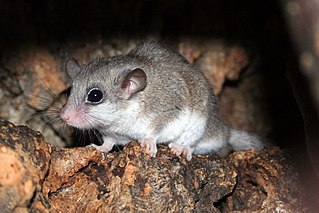 W
WA dormouse is a rodent of the family Gliridae. Dormice are nocturnal animals found in Africa, Asia, and Europe, and are particularly known for their long periods of hibernation.
 W
WFugaku Wind Cave is a lava tube at the northern foot of Mount Fuji, Japan. It is the largest of the several lava tubes that are found in the Aokigahara forest in Fujikawaguchiko Town, Yamanashi Prefecture.
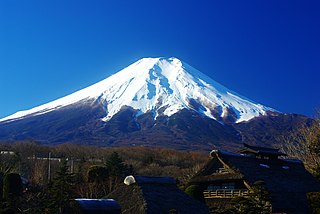 W
WMount Fuji , located on the island of Honshū, is the highest mountain in Japan, standing 3,776.24 m (12,389.2 ft). It is the second-highest volcano located on an island in Asia, and seventh-highest peak of an island on Earth. Mount Fuji is an active stratovolcano that last erupted from 1707 to 1708. The mountain is located about 100 km (62 mi) southwest of Tokyo and is visible from there on clear days. Mount Fuji's exceptionally symmetrical cone, which is covered in snow for about five months of the year, is commonly used as a cultural icon of Japan and it is frequently depicted in art and photography, as well as visited by sightseers and climbers.
 W
WGenbikei (厳美渓) is a two kilometer long ravine on the Iwai River in the city of Ichinoseki, Iwate Prefecture, Japan. It has been designated a National Place of Scenic Beauty and Natural Monument since 1927.
 W
WThe bean goose is a goose that breeds in northern Europe and Eurosiberia. It has two distinct varieties, one inhabiting taiga habitats and one inhabiting tundra. These are recognised as separate species by the American Ornithologists' Union and the IOC, but are considered a single species by other authorities, such as the British Ornithologists' Union. It is migratory and winters further south in Europe and Asia.
 W
WThe tundra bean goose is a goose that breeds in northern Siberia. This and the taiga bean goose are recognised as separate species by the American Ornithological Society and International Ornithologists' Union, but are considered a single species by other authorities. It is migratory and winters further south in Asia. The taiga and tundra bean goose diverged about 2.5 million years ago and established secondary contact ca. 60,000 years ago, resulting in extensive gene flow.
 W
WThe greater white-fronted goose is a species of goose related to the smaller lesser white-fronted goose. It is named for the patch of white feathers bordering the base of its bill, in fact albifrons comes from the Latin albus "white" and frons "forehead". In Europe it has been known as the white-fronted goose; in North America it is known as the greater white-fronted goose, and this name is also increasingly adopted internationally. Even more distinctive are the salt-and-pepper markings on the breast of adult birds, which is why the goose is colloquially called the "specklebelly" in North America.
 W
WGraphium doson, the common jay, is a black, tropical papilionid (swallowtail) butterfly with pale blue semi-transparent central wing bands that are formed by large spots. There is a marginal series of smaller spots. The underside of wings is brown with markings similar to upperside but whitish in colour. The sexes look alike. The species was first described by father and son entomologists Cajetan and Rudolf Felder.
 W
WThe great sugi of Kayano is a Cryptomeria (Sugi) tree at Yamanaka Onsen in Kaga, Ishikawa Prefecture, Japan. One of the four trees believed to be sacred in the precincts of the Sugawara Shrine, it has received the distinction of designation as a Special Natural Monument from the Agency for Cultural Affairs of Japan.
 W
WHakuto Shrine is a Shinto shrine in Tottori, Tottori Prefecture, Japan. In 1937, its trees were designated a Natural Monument.
 W
WHeirin-ji (平林寺) is a Rinzai temple of the Myoshin-ji branch located in Niiza city, Saitama prefecture, Japan, a city just outside Tokyo.
 W
WHōrai-ji (鳳来寺), Buddhist temple of the Shingon sect located in the city of Shinshiro, Aichi Prefecture, Japan. Its main image is a statue of Yakushi Nyōrai. The temple is located on the 695 metres (2,280 ft) Mount Hōrai and is accessed by a flight of 1425 steps. The grounds have been designated Place of Scenic Beauty and Natural Monument since 1931. The area is also noted for its population of Eurasian scops owl, the prefectural bird of Aichi Prefecture.
 W
WHotokegaura is a series of rock formations along the sea cliffs on the west coast of Shimokita Peninsula at the entrance to Mutsu Bay in far northern Japan. These rock formations were designed a Natural Monument of Aomori Prefecture in 1934, and became further protected from April 23, 1941 as a nationally designated Place of Scenic Beauty and Natural Monument, From 1968, the rock formations were also located within the borders of the Shimokita Hantō Quasi-National Park. In 1975, the surrounding waters were designated as Hotokegaura Marine Park.
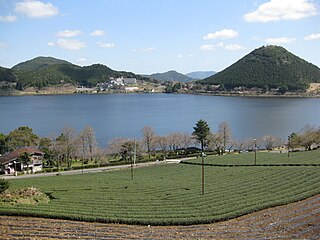 W
WImuta-ike (藺牟田池) is a freshwater caldera lake in Satsumasendai, Kagoshima Prefecture, Japan. It forms part of Imutaike Prefectural Natural Park. Its plant communities were designated a Natural Monument of Japan in 1921 and sixty hectares of wetlands were designated a Ramsar Site in 2005.
 W
WThe Institute for Nature Study is a nature preserve associated with the National Museum of Nature and Science, located in the Shirokanedai neighborhood of Minato, Tokyo, extending into the Kamiosaki neighborhood of Shinagawa, Tokyo. It is a Natural Monument and a National Historic Site.
 W
WLidth's jay or the Amami jay, is a passerine bird in the family Corvidae, native to Japan.
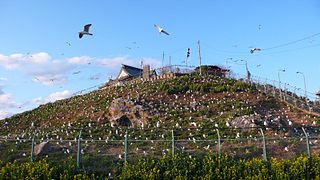 W
WKabushima (蕪島) is a small island located in Hachinohe, Aomori, in the Tōhoku region of northern Japan. Part of the Tanesashi Coast, it was incorporated into the Sanriku Fukkō National Park from May 2013.
 W
WThe Kai Ken is a breed of dog from Japan where it is a national monument. It is a rare dog even in its native land and is one of the six native Japanese dog breeds protected by the Nihon Ken Hozonkai.
 W
WKamagatani (霞間ヶ渓) is a valley in the in the town of Ikeda, Gifu Prefecture, Japan noted for a scenic valley. It is a noted spot for viewing cherry blossoms in spring and was designated both a nationally designated Place of Scenic Beauty and Natural Monument,in 1928 It is located within the borders of the Ibi-Sekigahara-Yōrō Quasi-National Park.
 W
WKamikōchi is a remote mountainous highland valley within the Hida Mountains range, in the western region of Nagano Prefecture, Japan.
 W
WKiritappu Wetland is a 3,168ha. wetland area in Hamanaka-cho, Akkeshi District, Hokkaidō, Japan. It is also called Wetland of flowers (花の湿原) because numerous flowers can be seen in summer.
 W
WThe Kishu , sometimes called Kishu Inu or Kishu dog, is a Japanese breed of dog. It is descended from ancient medium-sized breeds and named after the Kishu region, now Mie Prefecture and Wakayama Prefecture. This breed is similar to the Hokkaido, Shikoku and the Kai Ken. The Japanese originally used this breed of dog for boar and deer hunting. Like the Shiba, they are often quiet. Kishu will stalk prey quietly rather than bark. They are the most commonly used purebred native Japanese breed used for hunting boar to this day.
 W
WKiyotsu Gorge is a nationally designated Place of Scenic Beauty and Natural Monument on the border Yuzawa and Tōkamachi, Niigata Prefecture, Japan.
 W
WKotohiki Beach is located in Kyōtango, Kyōto Prefecture, Japan. It is a nationally designated Natural Monument and Place of Scenic Beauty, and forms part of the Tango-Amanohashidate-Ōeyama Quasi-National Park. In 1996, the Ministry of the Environment selected the sound of the sands as one of the 100 Soundscapes of Japan.
 W
WLake Sai Bat Cave is the largest of the several lava tubes that are near Lake Sai, in the Aokigahara forest in the northern side of Mount Fuji, Japan. It is known as a cave where visitors can observe the bats which live there.
 W
WThe Misaki is a critically-endangered Japanese breed of small horse. It is one of eight Japanese native horse breeds, and lives as a feral horse in a natural setting in a designated National Monument on Cape Toi within the municipal boundaries of Kushima at the south end of Miyazaki Prefecture on the island of Kyūshū. The Misaki was made a Japanese National Natural Treasure in 1953.
 W
WMonuments is a collective term used by the Japanese government's Law for the Protection of Cultural Properties to denote Cultural Properties of Japan as historic locations such as shell mounds, ancient tombs, sites of palaces, sites of forts or castles, monumental dwelling houses and other sites of high historical or scientific value; gardens, bridges, gorges, mountains, and other places of great scenic beauty; and natural features such as animals, plants, and geological or mineral formations of high scientific value.
 W
WThe Japanese murrelet or crested murrelet is a small bird that inhabits rocky islets and reefs in the warm waters of Japan and southern Korea. Its non breeding range includes Hokkaido and southern parts of Primorye and Sakhalin. It has black and bluish grey upper body and white underparts plumage.
 W
WHoukisugi or Hōkisugi at Nakagawa (箒スギ) is a 2000-year-old Japanese cedar (cryptomeria) at Nakagawa Settlement, Yamakita town, Ashigarakami District, Kanagawa Prefecture, Japan.
 W
WThe Narusawa Ice Cave is a lava tube located in the Aokigahara forest, in the part that belongs to Narusawa Village, Yamanashi Prefecture, Japan. It is one of the three larger lava tubes at the northern foot of Mount Fuji, the other two caves being Fugaku Wind Cave and Lake Sai Bat Cave. All three were designated as Natural Monuments of Japan in 1929.
 W
WThe Okinawa rail is a species of bird in the rail family, Rallidae. It is endemic to Okinawa Island in Japan where it is known as the Yanbaru kuina . Its existence was only confirmed in 1978 and it was formally described in 1981 although unidentified rails had been recorded on the island since at least 1973 and local stories of a bird known as the agachi kumira may refer to this species.
 W
WBlakiston's fish owl, the largest living species of owl, is a fish owl, a sub-group of eagle owls which specialize in hunting in riparian areas. It is native to China, Japan, and north-eastern Asia. This species is a part of the family known as typical owls (Strigidae) which contains most species of owl. Blakiston's fish owl and three related species were previously placed in the genus Ketupa; however mtDNA cytochrome b sequence data is equivocal on which of the two genus names is more appropriately applied for this species. Its habitat is riparian forest, with large, old trees for nest-sites, near lakes, rivers, springs and shoals that do not freeze in winter. Henry Seebohm named this bird after the English naturalist Thomas Blakiston, who collected the original specimen in Hakodate on Hokkaidō, Japan, in 1883.
 W
WOze Marshland is a high altitude marshland in the Oze National Park, Japan.
 W
WThe Japanese wood pigeon is a species of bird in the genus Columba in the family Columbidae. It is found along shorelines of the East China Sea. They are believed to be the largest representative of Columba, at 550 grams (1.2 lb) and 43 cm (17 in). Its natural habitats are temperate forests and subtropical or tropical moist lowland forests. The species is in decline owing to habitat loss, habitat degradation, deforestation and hunting. This wood pigeon is endemic to the laurel forest habitat.
 W
WRakuju-en (楽寿園) is a public park with a Japanese garden and zoo, located in the city of Mishima, Shizuoka Prefecture, Japan. It was designated as a National Place of Scenic Beauty of Japan and well as a Natural monument of Japan in 1954. In 2012, the Rakuju-en was designated as part of the Izu Peninsula Geopark
 W
WThe Ryūga Cave or Ryuga Cave, also known as Ryugado Cave, is a limestone cave located in Kami City, Kōchi Prefecture. It is one of the three largest limestone caves in Japan, with a total length of 4 km. The Cave took roughly 175 million years to form.
 W
WThe Sacred Nagi Tree of Kumano Hayatama Taisha is one of the Natural Monuments of Japan and is situated in Kumano Hayatama Taisha in Shingu city, Wakayama, Japan. Kumano Hayatama Taisha is one of three Kumano Sanzan shrine/temple sites, and is part of the UNESCO World Heritage Site "Sacred Sites and Pilgrimage Routes in the Kii Mountain Range". The nagi tree, Nageia nagi, is also called the broadleaf podocarpus.
 W
WThe Former Sagami River Bridge is the ruins of a Kamakura period bridge over the former course of the Sagami River, located in what is now the city of Chigasaki, Kanagawa Prefecture in the southern Kantō region of Japan. The site was designated a National Historic Site of Japan in 1926, with the area under protection expanded in 2007.It was further designated as a Natural Monument in 2013.
 W
WShōwa-shinzan is a volcanic lava dome in the Shikotsu-Toya National Park, Hokkaido, Japan, next to Mount Usu. The mountain was created between 28 December 1943 and September 1945. Initially, a series of strong earthquakes shook the area, and wheat fields were rapidly uplifted. Lava broke through the surface and the current peak was created. The peak is now 398 m (1,306 ft) tall, and still actively smoking.
 W
WTatami-ishi , literally "tatami stones", is a geological feature in Kumejima, Okinawa, Japan. Located on the south coast of the island of Ōjima , to the immediate southeast of Kume Island, it lies within Kumejima Prefectural Natural Park. Exposed at low tide, the feature comprises some one thousand pentagonal and hexagonal rocks, each 1 to 1.5 metres in diameter, stretching fifty metres from north to south over a length of two hundred and fifty metres. It was formed during the Miocene period by the columnar jointing of andesitic lava as it cooled and contracted. The name is derived from the resemblance to a room of close-fitted tatami mats, while the feature is sometimes also likened to a turtle's carapace. In 1967 Tatami-ishi was designated a Natural Monument by the Government of the Ryukyu Islands. With the reversion of Okinawa to Japan in 1972, it was redesignated a Prefectural Cultural Property. In 2014 an area of 29.3 ha was designated a national Natural Monument.
 W
WTōjinbō (東尋坊) is a series of cliffs on the Sea of Japan in Japan. It is located in the Antō part of Mikuni-chō in Sakai, Fukui Prefecture. The cliffs average 30 metres (98 ft) in height and stretch for 1 km (3,281 ft). The area is part of the Echizen-Kaga Kaigan Quasi-National Park.
 W
WThe Tokyo bitterling is a temperate freshwater fish of the carp family (Cyprinidae). Taxonomically, it belongs to the subfamily Acheilognathinae.
 W
WThe Tottori Sand Dunes are sand dunes located outside the city center of Tottori in Tottori Prefecture, Japan. At a length of 9 miles (14 km) and less than 1.5 miles (2.4 km) wide, it is the largest sand dune in Japan. The sand dunes are part of San'in Kaigan Geopark, which is part of The UNESCO Global Geoparks.
 W
WYabiji is the largest coral reef group in Japan, containing over 100 coral reefs and spanning about 17 by 6.5 km. Known for being above water level several times a year, most visibly around March 3, it was made a Natural Monument of Japan in 2013 as a place of Scenic Beauty. It is located about 6 km off the northern coast of Ikema Island.
 W
WThe Yoshimi Hundred Caves is a cluster of corridor-type kofun tombs dug in artificial caves in a tuff cliff of located in the town of Yoshimi, Saitama, in the Kantō region of Japan. It was designated as a National Historic Site on March 7, 1923. The Schistostega luminous moss growing at the site was also designated as a Natural Monument of Japan on November 30, 1928. The site is part of Hiki Hills Prefectural Natural Park.